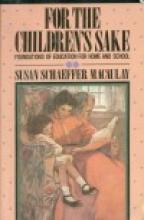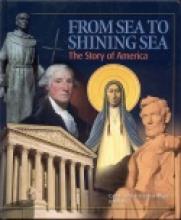No name
Follow the Line Around the World
For the Beauty of the Earth
Like many Catholic Home schooling families, providing a Catholic education was number one on the list of reasons my husband and I wanted to home school. In addition, we wanted a rigorous education, and one that emphasized the beauties of truth and love. Translating these goals into a curriculum is an on-going challenge. Sometimes the books that do a good job presenting a particular subject do it without the light of the Faith. Other times, books that are "solidly Catholic" are also unattractive and uninspiring. We have had to compromise in a lot of areas.
Two that we have not had to compromise in are science and history, and this is largely due to the Catholic school supplements produced by James Leek. These two are among the most excellent resources I have come across in home schooling. They include interesting material for study and careful explanation of an approach to education that is beautifully in keeping with our holy faith. In themselves, these explanations are worth reading and incorporating into your teaching.
In science, for example, Mr. Leek explains the integrating principles for a Catholic science education. Ultimately, our aim is to better know the Creator of everything. Science study also has remote ends: that we develop a respect for God's creation, and learn to contemplate and reflect on it, and that we exercise our minds to improve life and serve our fellow men. At the same time, science has its proximate and immediate ends: to learn how the world works and to take in sensory data of the physical reality around us.
These principles are very well realized in Leek's science supplement. For the Beauty of the Earth includes a textbook with literary selections organized around the common subject matter of science. The lyrics of the beautiful hymn from which this program draws its title provide the organizing system. In addition to "the beauty of the earth" (weather, metals, energy), we have chapters on "the glory of the skies" (stars, the sun), "hill and vale and tree and flower" "the mystic harmony linking sense to sound and sight" (insects, spiders, mammals), and "the joy of human love" (the senses, emotions, the will.)
The corresponding teacher's guide builds on the readings with questions and activities that take the student from considering the text, to observing the natural world, to admiring God's handiwork, and finally, to the religious analogy. An example to illustrate this progression would be the reading of "Phaeton and Apollo." After the selection is read, the student is asked a series of questions on the text: Who was Phaeton? Describe the court of the sun, etc. Next, students are asked to make some observations about the sun: Where does it rise and set? Does it actually move? What makes it appear to move? Then they are asked to consider the sun's role in life on our planet, and finally, to how the sun is like God, how its marvelous working points to the existence of God.
Questions and activities are broken into grade levels so that this program can be used throughout the elementary years. My first reaction when I looked at For the Beauty of the Earth was to think that this was a liberal arts soft-pedaling of the hard subject of science. But after I carefully read the author's introduction, I decided it could be so much more than that, and it more than met those expectations. We used it alternately with our regular science text, allowing the literary selections and projects to set the tone for our textbook's coverage. Along with enjoying some good stories, memorizing poems and scriptures, doing some fun projects (like building a humane mousetrap), I found that the sense of wonder created through the program carried into the rest of our textbook consideration of each topic. The course is cross-referenced with many of the most popular school science text series from the time it was published (early 1980s).
For the Children
This is a lovely book with color photos of the Holy Father with children and quotes from speeches and letters that the Holy Father has addressed to children throughout the world. I was so pleased to find such an appealing Catholic book with color pictures and solid text.
The Pictures: Besides photos of the Pope holding and hugging children, there are: a large first communion class pictured with the Pope, a bishop and a number of nuns (in full habit); children from around the world praying (these are very beautiful and quite reverent - such as a group of girls from South Korea in traditional costume in addition to lace chapel veils singing); a picture of the Pope in a classroom looking at a young boy's schoolwork, children stopping their play by a river to look up and wave at the Pope driving by in the "popemobile", two young children receiving their First Holy Communion from the Holy Father (on the tongue!), a baby being baptized by the Pope, and a vintage picture of the Holy Father at his own First Holy Communion (along with a few paragraphs of his remembrance of the occasion).
The Text: Even better than the pictures is the text. Rather than someone else's interpretation of the Pope, we have the Pope himself, appealing to children to pray for him and for the world, to remember Jesus in the Eucharist even in their play and on vacation, renounce violence and learn to love peace in the way the Lord teaches us. They are very thoughtful and powerful passages to read and reflect upon for children of all ages The quotes are well-chosen and are so beautiful and revealing and contain so much truth about children that they would also make excellent meditations for newly-married couples and expectant mothers (and really all parents - even the best parents can use a healthy reminder of the great gifts God has given us in our children - particularly when the house is torn apart, the two year old is wreaking havoc and the baby is crying!!).
Binding details: padded hardback
For the Children's Sake
The information in this book is mostly gleaned from the writings of Charlotte Mason, a 19th century educator who has had a great deal of influence on the homeschooling movement of the late 20th century.
This book will help you look at your child's educational needs and potentials outside the realm of the "school system." The ideas and suggestions are fresh and creative (and especially helpful for the early years). I especially like her focus on introducing children to great art, great music and great literature. After reading her book, I put on a Mozart CD especially for my three year old daughter to listen to - and was delighted to discover that she loved it! A trip we made to an art museum became a treat for her and much more enjoyable for my husband and I because of some other ideas we tried from the book.
Her description of "twaddle" (books and materials that are inferior, "cheezy", - especially many books "written down" to a child's level. etc.) and why to avoid it is so refreshing. Some of these ideas could well be applied to Catholic books - which should not only be Catholic in content, but intelligent and beautiful in presentation. We live in a culture that encourages us to fill our lives with loads and loads of cheap clutter that's usually made in China. I'm trying to buy things more carefully. When choosing new materials for school or even toys for Christmas I'm trying to find things that are beautiful and lasting. This also forces me to buy fewer things because the quality can be more expensive. I believe this is better for my children and my sanity!
For the Love of Literature
Foyle's War
Guest review by the Hogan Family
From Sea to Shining Sea
From Slave to Priest
Fun with Roman Numerals
I showed this book and read it aloud to my kids in Junior Classical League's last meeting, and except for one kid, the club's president and a Latin aficionado, none of us knew about the Roman numerals on the two last pages! Have fun learning!
From the publisher:
Page IV, Super Bowl XLV. Built in MMVIII. Roman numerals are everywhere---on clocks, in books, and on buildings. But what do Roman numerals mean, and how does one use them? Fun with Roman Numerals is a straightforward and appealing introduction to a timely topic. On a scale of I to X, it's an XI!








